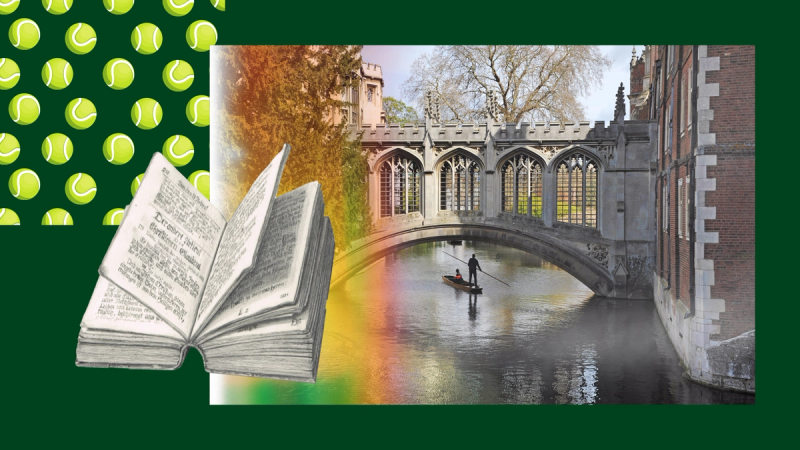In the late 1590s, before he became chaplain to King James, a translator of the Authorized Version, a British delegate to the Synod of Dordt, or Lady Margaret Professor of Divinity, Samuel Ward was a twenty-something student at Christ College, Cambridge. In those supposedly happy days, he kept a little volume in which he recorded both his lecture notes and his misdeeds. Self-exhortations based on talks from Laurence Chaderton and William Perkins—towering Cambridge theologians under whom Ward studied—jostle on each page with long, detailed lists of transgressions: overeating, oversleeping, spending more time in bowling and tennis than in worship, being prideful and sharp-tongued, and sluggishness in prayer.
Modern scholars have suggested on the basis of Ward’s personal account book that he was not the usual college student, the kind in Cambridge today who in summertime pile onto punts and float down the River Cam carefree, Pimm’s in hand. Instead, they argue, he was excessively rigid, obsessed with self-scrutiny, even ridiculous—in every way a “Puritan.” When the talented twentieth-century English historian Hugh Trevor-Roper read the dozen references in Ward’s diary to overindulging in fruit—pale though probable imitation of the writing in Augustine’s Confessions, book two, on stolen pears—he dismissed Ward as “our old plum-guzzling friend.” Trevor-Roper cracked: “Was he of the Elect? Could he be in a state of grace? or had he eaten too much at dinner in college last night—had he tucked too freely into those plums, damsons, walnuts, cheese, to which he was so partial?” Yet there is one confession more intriguing than all these—namely, Ward’s lament from July 19, 1596: “My drowsiness in reading Ursinus.”
“Ursinus” was, into the seventeenth century, the catechism for all Reformed Protestants on both sides of the English Channel. Published in 1563, the Heidelberg Catechism is principally the work of Zacharias Ursinus, Heidelberg professor of theology, although other contributors from the Heidelberg theology faculty included at least Caspar Olevianus. Ursinus also wrote the so-called Smaller and Larger Catechisms, circa 1561–1562, but his name became a byword for the Heidelberg Catechism virtually from the beginning. The catechism was initially drawn up at the request of Elector Frederick III, ruler of the Rhineland Palatinate, the most important German province at the time. Several Dutch synods subsequently approved it, including the Synod of Dort between 1618 and 1619, where it was adopted as one of the “Three Forms of Unity,” together with the Belgic Confession and the Canons of Dordt. Even now it remains a doctrinal standard for numerous Reformed denominations that trace back to Dordt and to the Continental stream.
Ward’s entry points to the catechism reach well beyond its German and Dutch provenance. In 1565, Frederick III sent a copy of it to Elizabeth, queen of England, along with advice on her marriage, though she did not acknowledge the gift. The first English translation appeared in London in 1572 by William Turner, who gave it the title Catechisme for children. Then the spigot opened, not only for subsequent English editions of the catechism but also for new Latin editions and English translations, produced in England, of the commentaries on the catechism by Ursinus and by his Heidelberg colleague, Jeremias Bastingius. An important 1588 edition of the catechism, produced by Thomas Sparke, expressed desire that the catechism be “generally received and used, both privately and publicly, in this church in England.” Sparke urged households to obtain copies of Ursinus’s lectures as well. He declared that “by the help of this book, and Ursinus’s Catechism in English, God has taken all excuse away, both from minister and householder, if they can but read English” to see their congregations and families catechized. Sometimes English readers used the Heidelberg Catechism without even realizing it. For example, numerous works appeared in London and other cities with titles such as R. B.’s A Brief Catechisme (1601), G. E.’s The Christian School-Maister, or a Dialogue between the Maister and the Scholler (1613), and E. B.’s A Catechisme or Briefe Instruction (1617), the texts of which are lifted entirely from the Heidelberg Catechism. One of the most popular English books of the period was John Mayer’s The English Catechisme Explained (1621), a commentary on the short catechism in the Book of Common Prayer that went through multiple editions. He wrote it in conscious imitation of Ursinus.
Ward’s diary also provides evidence not of the soporific but of the cherished and beloved nature of the catechism, albeit the sort of love that students have for their favorite professor who happens to teach at 8:00 a.m. on a sunny, summer day—otherwise he would not have recorded his attempts to read with diligence. He probably read, and referred to in his notes, Ursinus’s lectures on the catechism in Latin. In fact, nearly all English students read the catechism itself along with one of the commentaries by Ursinus or Bastingius. In 1579, the University of Oxford prescribed the Heidelberg Catechism as a set text to be used by all juniors in the university and those without degrees, who were required to receive instruction privately by tutors and publicly in college by appointed catechists, with annual examinations. (Poor performers faced punishment by the vice-chancellor.) By contrast, both the Thirty-Nine Articles of the Church of England and the official Apology of the Church of England by John Jewel remained optional reading. The Heidelberg Catechism was the only catechism to be printed in Oxford, and two editions from 1588 bear the arms of the university on the title page. As Ward’s diary attests, similar use occurred in Cambridge. Thomas Dugard, a diarist and future clergyman, noted when he was in Cambridge between 1632 and1633 that all Cambridge students were regularly reading the catechism. Thomas Goodwin, one of the Westminster divines, recalled how college fellows at Cambridge “explained it to their pupils on Saturday night with chamber-prayers.” Goodwin himself dutifully studied Ursinus’s commentary when he prepared to take communion in college for the first time. College students in Aberdeen, among other Scottish universities, all studied both the Heidelberg Catechism and Ursinus’s lectures well into the seventeenth century, like their neighbors south of the Tweed.
Throughout Scotland, in fact, the Heidelberg Catechism received semi-official status. King James VI of Scotland endorsed it in 1591 and had it published in another English translation by the royal printer in Edinburgh with the specific declaration on the title page that it was “authorized by the Kings Majesty, for the use of Scotland.” The book included extracts from Bastingius’s recent commentary. In 1615, the catechism was reaffirmed when it was published in a combined volume with a calendar, a psalter, and John Knox’s Book of Common Order. This second Scottish edition is particularly noteworthy. Not only does it bear the declaration that it was officially “appointed to be printed for the use of the Kirk in Edinburgh,” but it also shows how the Scots included the catechism among the primary liturgical documents of the church.
There were many more English editions of the Heidelberg Catechism created during the Long Reformation and more many deep connections that tied “Continental” and “Puritan” together—indeed, careful reading will confirm that both together comprise one basic Reformed tradition. Even in 1645, when the Westminster Assembly worked on its own catechism, a new expanded edition of Ursinus’s commentary, the Summe of Christian Religion . . . More Enlarged, appeared in English translation from a notable London printer. As a point of comparison, Ursinus’s work went through more English editions between 1587 and 1643 than did the English translation of John Calvin’s Institutes of the Christian Religion, despite the fact that “Ursinus” was still a big book, running to over one thousand pages in its quarto editions. “Calvin’s Institutes are often talked of as constituting the pre-eminent work of Continental Reformed divinity circulating in Elizabethan and early-Stewart England, but from the late 1580s onwards this [honor] seems to belong to Ursinus’s Summe of Christian Religion.” So much history depends on what takes place elsewhere, and so Heidelberg takes its place as one of the important sites for the development of English Protestantism.
In 1610, Ward became master of Sydney Sussex College, Cambridge, which had been only recently founded. Among his resolutions, he listed the maintenance of true religion along with learning in the college and the encouragement of Sabbath observance and prayers for the advancement of true preaching. Ursinus and the Heidelberg Catechism thus found yet another Anglophone home. Perhaps Ward also recommended that students consume coffee, not plums, while they read.
Footnotes
Jeffrey Alan Miller, “The Earliest Known Draft of the King James Bible: Samuel Ward’s Draft of 1 Esdras and Wisdom 3–4,” in Labourers in the Vineyard of the Lord: Erudition and the Making of the King James Version of the Bible, ed. Mordechai Feingold (Leiden: Brill, 2018), 187–265; Anthony Milton, ed., The British Delegation and the Synod of Dort (1618–1619),(Woodbridge, Suffolk: The Boydell Press, 2005).
BackM. M. Knappen, ed., Two Elizabethan Puritan Diaries (Chicago: American Society of Church History, 1933), 103–123.
BackSee the splendid critique of this caricature in Margo Todd, “Puritan Self-Fashioning: The Diary of Samuel Ward,” Journal of British Studies 31 (July 1992): 236–64.
BackHugh Trevor-Roper, Catholics, Anglicans, and Puritans: Seventeenth-Century Essays (London: Secker & Warburg, 1987), 49, 74.
BackKnappen, Two Elizabethan Puritan Diaries,113.
BackFor English translations of these, see Lyle D. Bierma, An Introduction to the Heidelberg Catechism: Sources, History, and Theology (Grand Rapids: Baker Academic, 2005), 137–223.
BackCalendar of Letters, Despatches and State Papers Relating to English Affairs Preserved Principally in the Archives of Simanacas (London: Longman, 1862–1954), 1:312.
BackZacharias Ursinus, The Summe of Christian Religion . . . (Oxford, 1595); Jeremias Bastingius, An Exposition or Commentarie upon the Catechisme of Christian Religion . . . , 5th ed. (Cambridge, 1614).
BackA Catechisme, or Short Kind of Instruction . . . (Oxford, 1588),sig. a5r–v; English spelling modernized here and throughout this essay.
BackA Catechisme, or Short Kind of Instruction, sig. A4v, 4–5.
BackJohn Mayer, The English Catechisme Explained (London, 1622), sig. 3v.
BackC. M. Dent, Protestant Reformers in Elizabethan Oxford (Oxford: Oxford University Press, 1983), 81, 87–93, 186–87.
BackBritish Library, Add Ms 23146, cited in Anthony Milton, “A Missing Dimension of European Influence on English Protestantism: The Heidelberg Catechism and the Church of England, 1563–1663,” Reformation & Renaissance Review 20 (2018): 241.
BackThomas Goodwin, The Works of Thomas Goodwin, D.D., 5 vols. (London, 1681–1704), 5:v, x.
BackG. D. Henderson, Religious Life in Seventeenth-Century Scotland (Cambridge: Cambridge University Press, 1937), 62, 245n1, 256n17.
BackA Catechism of Christian Religion. . . (Edinburgh, 1591); English modernized.
BackThe CL Psalmes of David . . . (Edinburgh, 1615).
BackZacharias Ursinus, The Summe of Christian Religion . . . More Enlarged (London, 1645).
BackMilton, “A Missing Dimension,” 241–42.
BackMargo Todd, “‘An Act of Discretion’: Evangelical Conformity and the Puritan Dons,” Albion 18 (1986): 581–99.
Back









